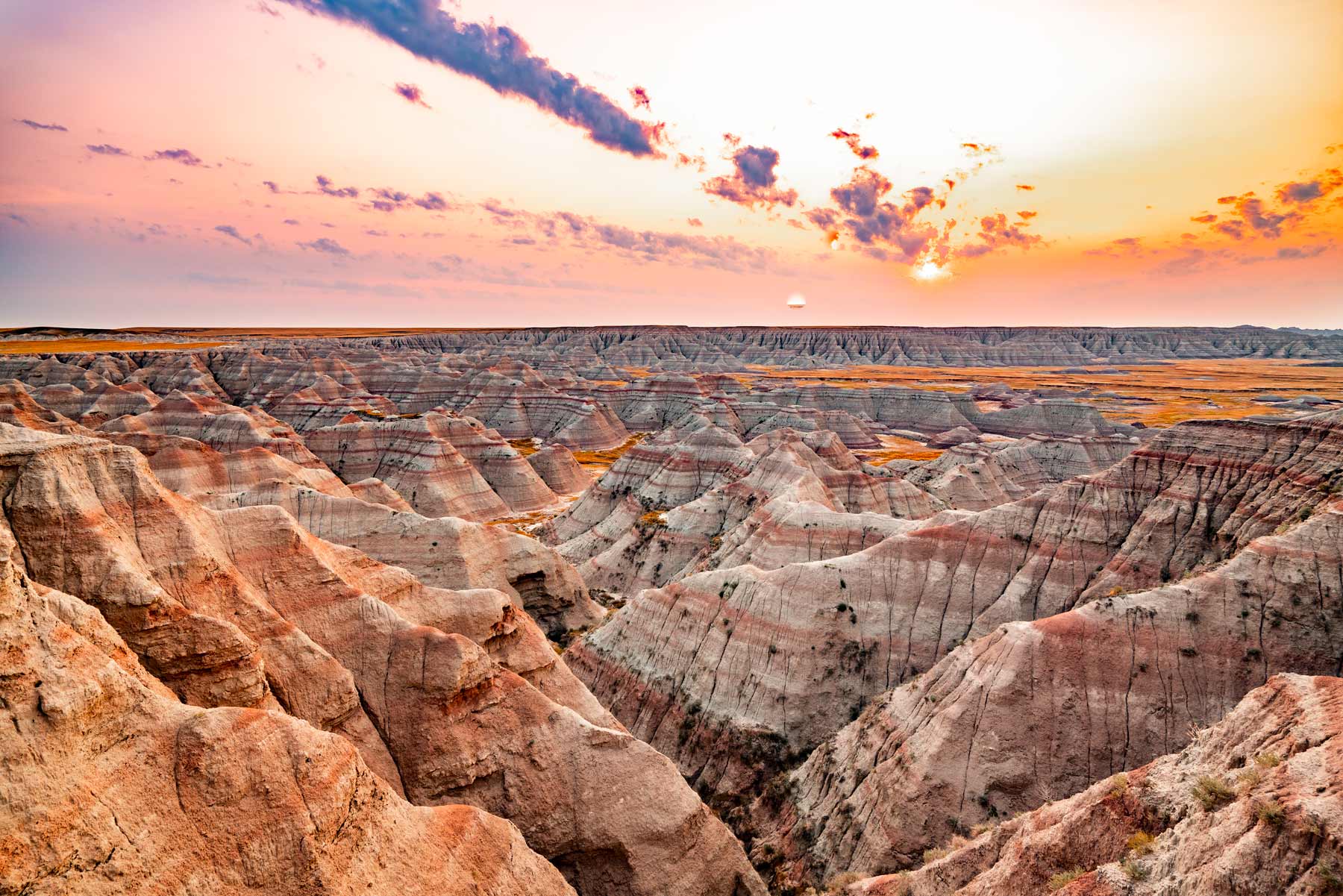
Situated in the heart of the Northern Great Plains, Badlands National Park spans 244,000 acres of spectacular landscapes, diverse wildlife, and the largest undisturbed mixed grass prairie in the United States.
Here, you’ll discover a land where bison still roam and towers rise from the prairie in dazzling formations. This vast, unending prairie is draped in a beautiful silence where the only sounds to be heard are the uninterrupted winds of the prairie and the song of the western meadowlark.
To find out when, where, and why to go to this western prairie wonderland – read on!
Our Travels to Badlands National Park

I first visited the Badlands with my brother Will and my Dad back in 2016 as we endeavored to make a film on the park. It was early April and the park was completely devoid of tourists and seemed magical.
The landscapes were dazzling and seemingly unending, and I knew then that I would be coming back for future visits.
Making The Badlands Film
As it was early April, the nights were cold, and the days weren’t much warmer. The prairie wind howled and routinely gusted upwards of 50 miles an hour. Our cameras and tripods were toppled many times resulting in the damage of no small amount of equipment.
But we adapted to the weather and managed to find ravines and nooks out of the whipping wind that provided the shots you see in our film.
Visiting in April meant the park was just about empty. We spent weeks there and rarely saw another person in our travels. The wildlife was abundant, and the vast silence of the prairie was something I’ll never forget.
Night skies were filled with stars, and our cameras even picked up a faint glow of the northern lights.
Why I Continue to Come Back to Badlands
I’ve heard it said that the Badlands is “an interstate park”, meaning a good park to pop into off of the interstate, but not necessarily one to plan a trip around. I’m here to tell you that Badlands National Park is well worth planning a trip around.
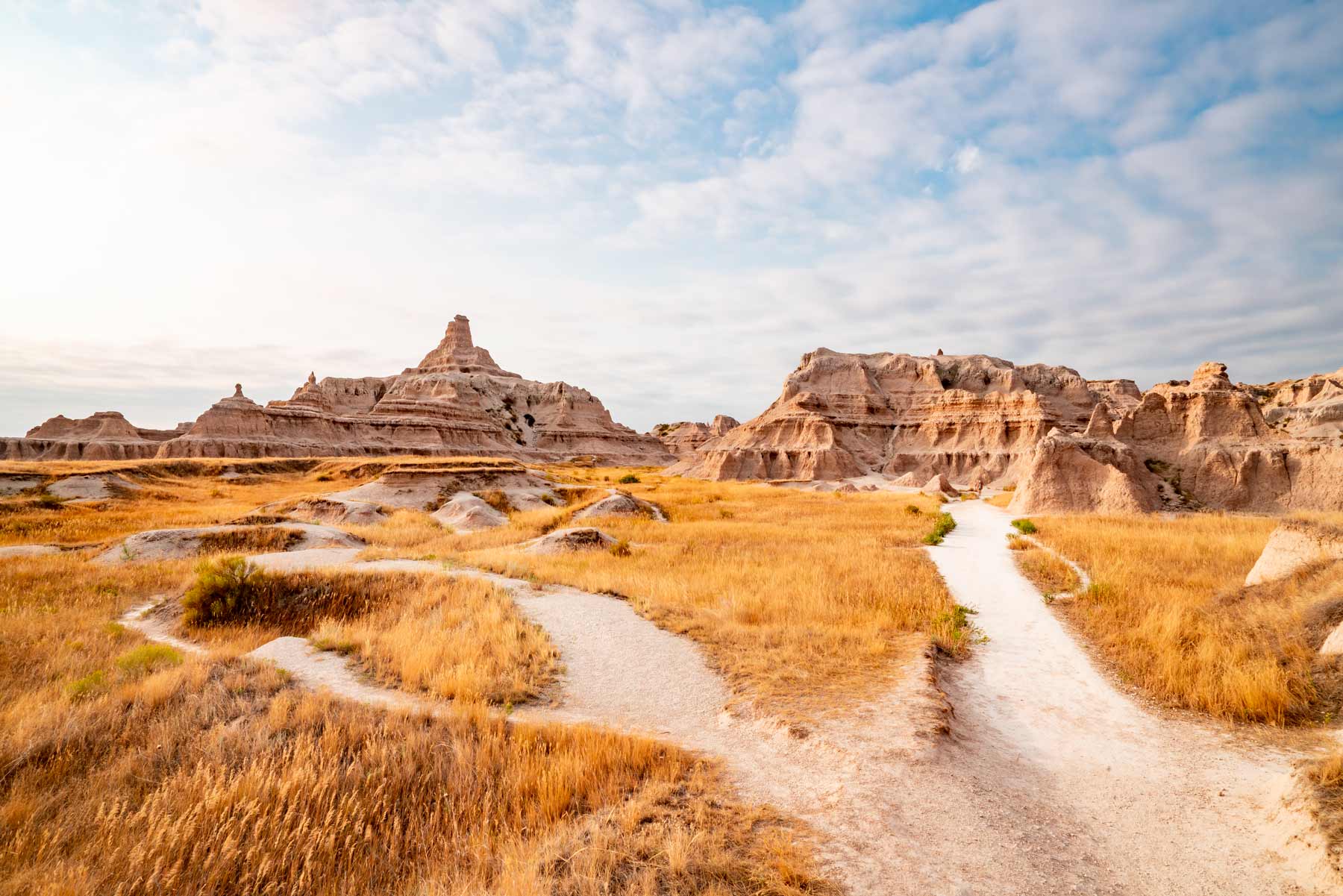
I’ve returned to the Badlands probably five or six times since my initial visit, and every time, I’m simply blown away.
Taking in a sunset somewhere near the Sage Creek turn off as the golden light transforms the landscape all around you is something you can never be prepared for and an event that’s sure to leave a lasting memory.
Badlands National Park is a Special Place
Watching the amber light sweep across the formations in the distance as the sun puts on its final dazzling show is truly something to behold.
Hearing the distant grunts of the bison from miles away, the yips of the coyotes, and the evening song of the meadowlark will make you feel transported, as if the cars, cities, and buildings that brought you here never existed.
Yes, the Badlands is a special place that stands in affirmation of everything America’s National Parks represent. It’s a place I’ll continue to revisit to revel in its quiet and spacious beauty.
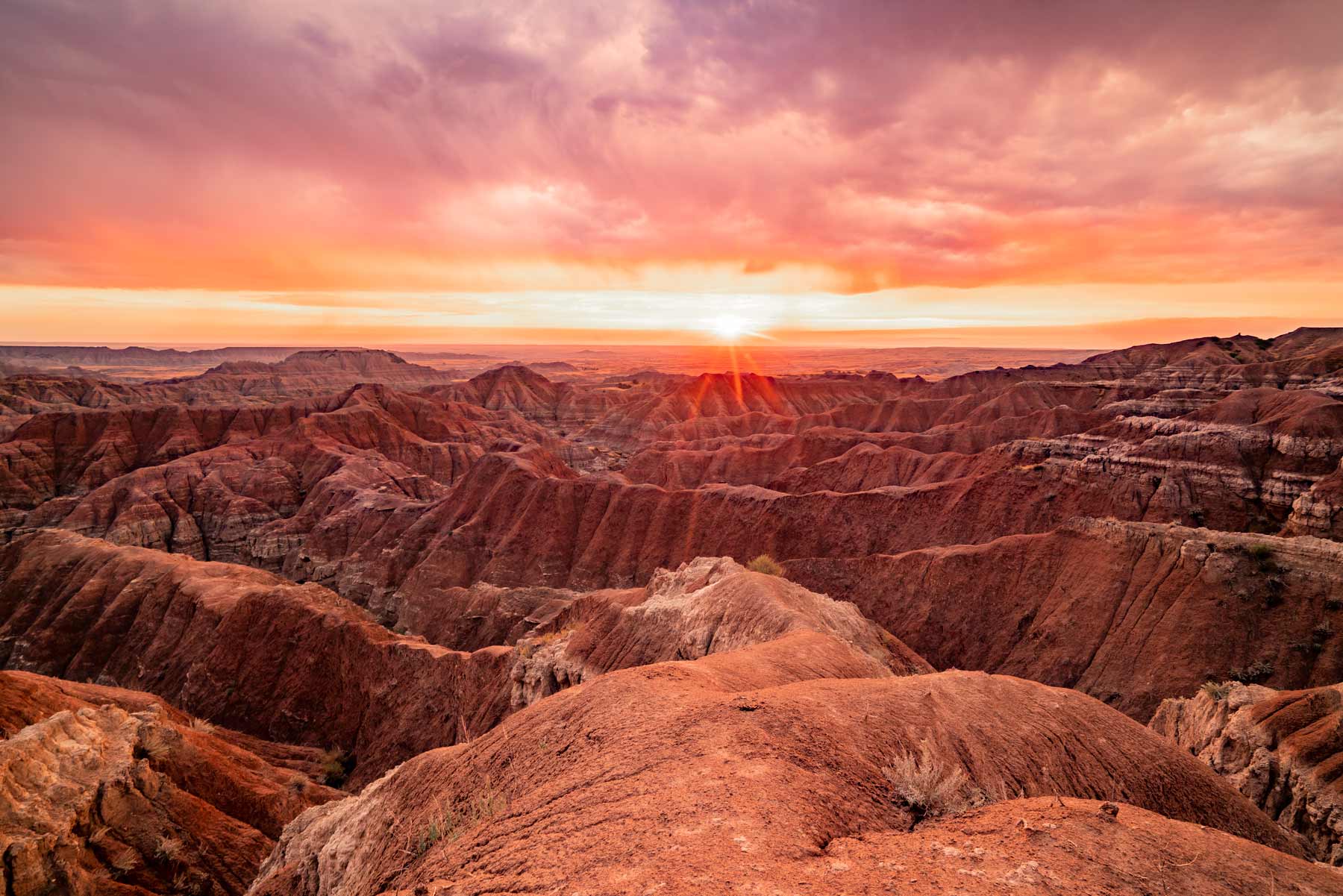
Badlands National Park Guide
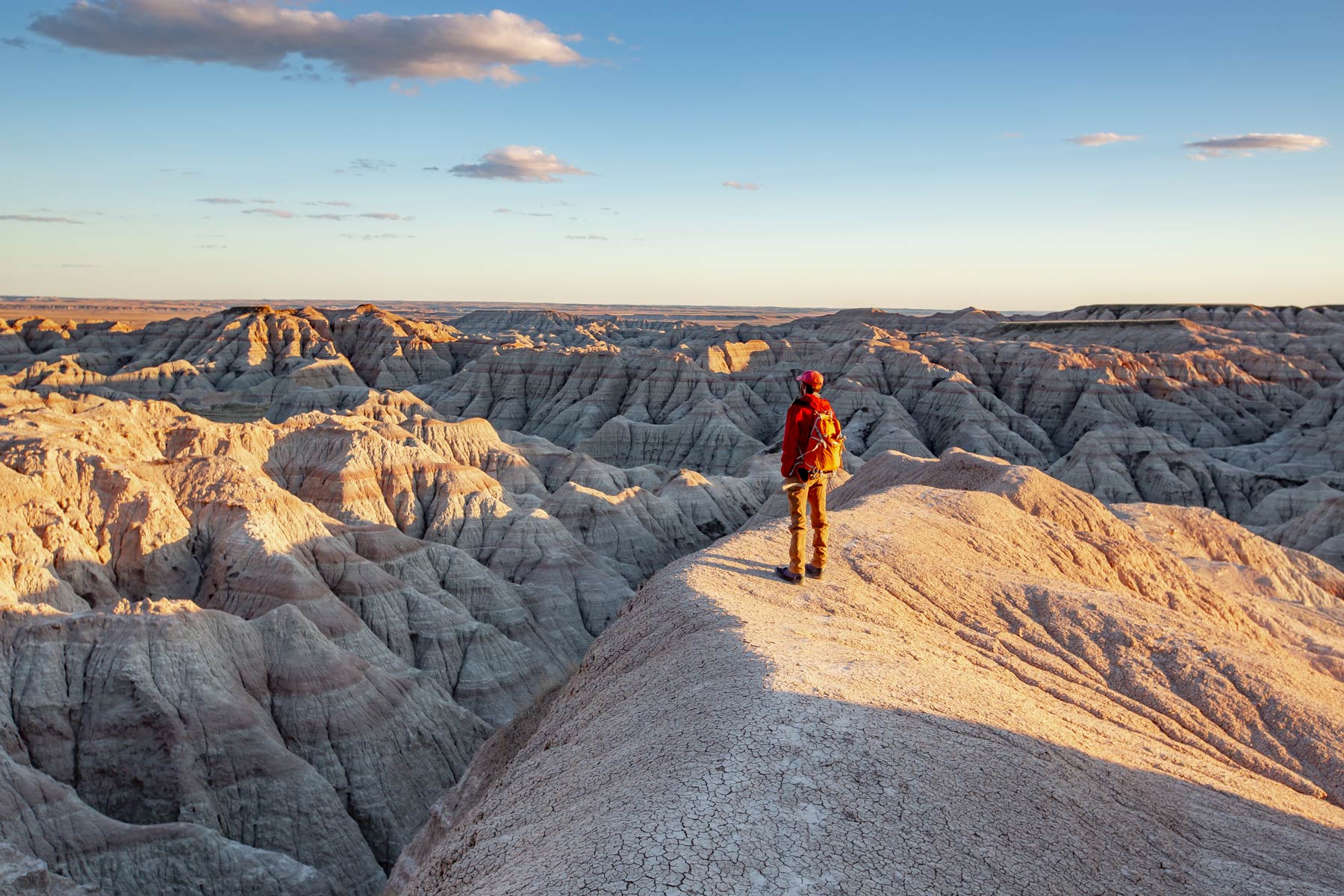
Things to Know Before You Visit
Entrance Fees: $30
Getting Around: Badlands is a very accessible park with the main park road taking visitors through various viewpoints, hiking opportunities, and interesting sites. Any vehicle will do in the main unit of the park, but you’ll need a 4WD high-clearance vehicle if you’re interested in venturing into the seldom-visited south unit of the park. Either way, prepare for some scenic driving!
The Best Map: I like this map best for Badlands National Park.
The Best Guide Book: I like this guide book the best for Badlands.
Sunscreen: Visiting national parks during certain times of the year can mean lots of sun. Seriously, some of these parks can zap you if you don’t wear sunscreen. We happen to like this one because it works, AND it’s not full of a bunch of chemicals.
Leave No Trace: We’re big fans of Leave No Trace here at MTJP. Want to learn more? Read about the seven principles of Leave No Trace here.
Insect Repellent: You hope not to need it, but you want to have it. We typically bring an Eco-Friendly Insect Repellent with us just in case.
Dogs are not allowed on trails in most national parks due to their potentially disruptive presence in the natural ecosystem. The basic rule is they are allowed where cars can go so be sure to check the rules before bringing along your furry friend.
Details About Badlands National Park
Location: South Dakota
Established: November 10, 1978
Size: 242,756 acres
Visitors: 1,008,942 (2020)
Entrance Fees: $30/vehicle
The History of Badlands National Park
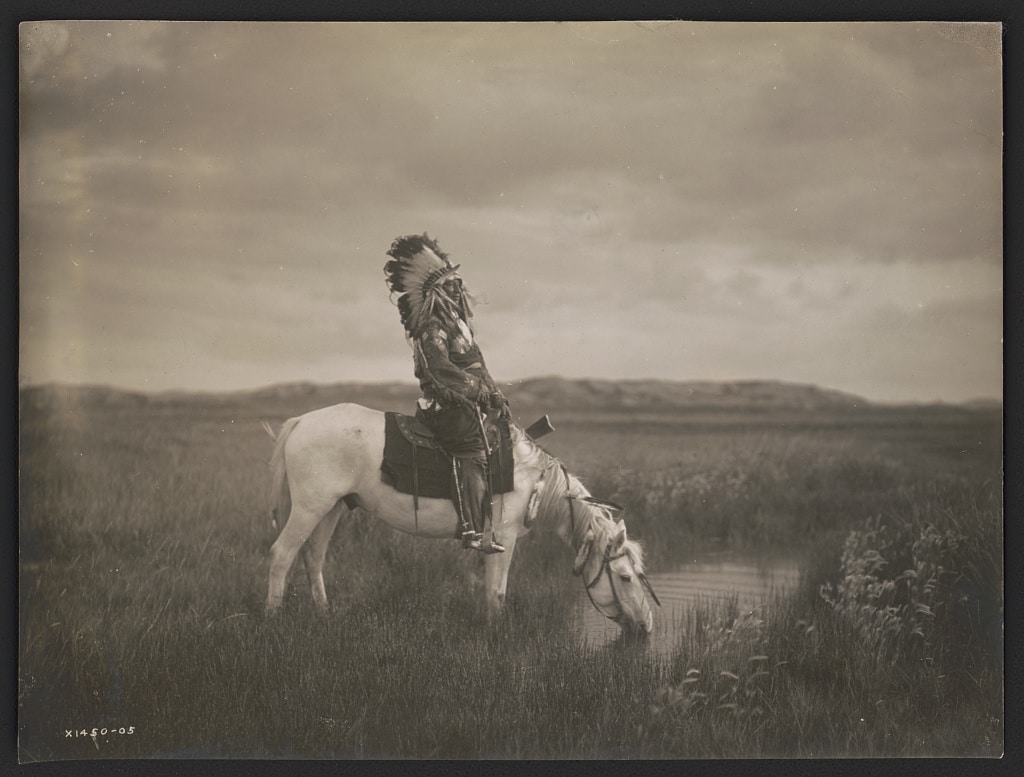
A Land of Beauty and Profound Tragedy
Native Americans have inhabited the area comprising Badlands National Park for more than 11,000 years. Paleo-Indians and later the Arikara and Sioux hunted and camped in the valleys and plains near freshwater sources where bison and other game were plentiful.
The tall badlands proved useful for spotting herds and potential enemies on the prairie in the distance. Bands of Native Americans typically hunted throughout the year here until winter set in, when they would follow the bison to warmer areas with more easily accessible water sources.
“My grandfather gazed down at me, and his words burned in my mind. He said back then, as today, the Lakota lived as one with nature.
– Introduction to Heritage Center Location Study for Oglala Lakota Heritage Center on South Unit of Badlands National Park
The land, sky, water, and the four-legged still are interconnected with the Lakota who are original members of the buffalo nation (Pte Oyate). Each and everyone is respected for their place in the web of life“.
Homesteaders & The Dawes Act
By the late 19th century, homesteaders began to move into the area, and in 1887, the U.S. Government passed the Dawes Act, which effectively stripped Native Americans of most of their land in a supposed attempt to encourage them to “assimilate” into mainstream society.
Another stated goal of the Dawes Act was to create divisions among Native Americans and eliminate the social cohesion of tribes.
The result was disastrous for Native Americans. Stripped of their lands and their ability to hunt and crowded into reservations with miserable living conditions, many looked in vain for a way to restore their previous way of life.
They told the people they could dance a new world into being. There would be landslides, earthquakes, and big winds. Hills would pile up on each other.
– Lame Deer
The earth would roll up like a carpet with all the white man’s ugly things – the stinking new animals, sheep and pigs, the fences, the telegraph poles, the mines and factories.
Underneath would be the wonderful old-new world as it had been before the white fat-takers came. …The white men will be rolled up, disappear, go back to their own continent.
The Ghost Dance
For many in the Badlands region, their new living conditions were particularly harsh. Thousands became followers of a Paiute prophet whose vision called on people to perform the Ghost Dance, which would reunite them with the spirits of their ancestors and bring about an end to white western expansion.
After being stripped of their lands and starved many Lakota began practicing the Ghost Dance in a desperate attempt to reverse their fortunes.
Disaster Strikes

The Ghost Dance frightened many white Bureau of Indian Affairs supervisors in South Dakota, who feared an uprising and quickly called for military reinforcements.
BIA supervisors singled out famed Hunkpapa Lakota leader Sitting Bull for arrest for failing to stop his people from performing the ghost dance. In the attempted arrest, Sitting Bull was killed.
Two weeks later, on December 28th, 1890, Spotted Elk and his band of Miniconjou Lakota were stopped by a detachment of the 7th cavalry regiment containing some 500 soldiers while en route to the Pine Ridge Indian Reservation.
The Massacre at Wounded Knee
The cavalry forced the Lakota to camp at Wounded Knee Creek (less than 40 miles from the present-day park) that night in the snow. The next morning, the army surrounded the small encampment and went in to disarm the band of Lakota.
During the disarming, two soldiers ordered a Lakota man named Black Coyote to give up his rifle. The soldiers were repeatedly informed that Black Coyote was deaf and could not understand them, but they persisted.
“If they had left him alone he was going to put his gun down where he should. They grabbed him and spinned him in the east direction. He was still unconcerned even then. He hadn’t his gun pointed at anyone.
– Wasumaza (Wounded Knee survivor)
His intention was to put that gun down. They came on and grabbed the gun that he was going to put down. Right after they spun him around there was the report of a gun, was quite loud.
I couldn’t say that anyone was shot, but following that was a crash”
Chaos and Bloodshed
As they grabbed Black Coyote from behind to disarm him, his rifle went off. The soldiers then opened fire into the camp, killing more than half of the Lakota men before they ever had a chance to raise their guns.
Some of the Lakota men grabbed rifles from the pile of confiscated weapons and returned fire. At this point, soldiers manning the four rapid-fire Hotchkiss Mountain guns pointed at the camp indiscriminately opened fire, killing women, children, and even some of their own men.
Army officers lost control of their men as they chased down fleeing Lakota men, women, and children and killed them.
Historian Dee Brown estimates that 300 of the 350 Lakota were killed or wounded, with only 51 survivors being loaded onto wagons and returned to the Pine Ridge Reservation. The Army reported 25 dead and 39 wounded soldiers.
The End of an Era
The massacre at Wounded Knee marked the end of an era for Native Americans and the United States. Hostilities between the U.S. Army and Native Americans largely concluded in the ensuing years, and the period historians refer to as the American Indian Wars wound down.
The ghost dance had ended in profound tragedy. The destruction of a people and their way of life was nearly complete.
“I can still see the butchered women and children lying heaped and scattered all along the crooked gulch as plain as when I saw them with eyes still young.
– Black Elk
And I can see that something else died there in the bloody mud, and was buried in the blizzard. A people’s dream died there.
It was a beautiful dream . . . the nation’s hoop is broken and scattered. There is no center any longer, and the sacred tree is dead.”
Stronghold Table in the South Unit of Badlands National Park was the site of several ghost dances in the 1890s and is believed to be the site of the last known ghost dance of the 19th century.
Today, the South Unit is managed by the Oglala Sioux Tribe in cooperation with the National Park Service. The site of the Wounded Knee Massacre is some 40 miles from Badlands National Park on the Pine Ridge Indian Reservation.
Recommended Reading: Bury My Heart At Wounded Knee by Dee Brown An Indigenous Peoples' History of the United States by Roxanne Dunbar-Ortiz
Adding Insult To Injury | Bombing Sacred Badlands
Fast forward to 1942 as the United States was entering the second world war. The area comprising what is now the south unit of Badlands National Park was part of the Pine Ridge Indian Reservation, where native families continued to live and work.
In a cruel twist of fate, the U.S. Government seized over 340,000 acres of this culturally and spiritually significant reservation land through the use of eminent domain to establish an aerial bombing range.
Not only were the Oglala Lakota forced to pick up and leave their homeland (again), but the Air Force would be routinely bombing the sacred land they fought so long to protect.
Furthermore, the National Park Service states that:
“the acquisition of the Bombing Range increased competition for land in the area and inflated the price of replacement sites to the point that the relocated persons were not able to buy substitute land with the compensation they had been paid. In many cases, individuals were forced to dispose of their livestock because their rangeland had been taken“.
If You Can Believe It, It Gets Worse
Long after the war, in 1968, the Air Force finally declared all but 2,486 acres of the bombing range as excess property and the land was returned to the Oglala Sioux Tribe. But not without a catch. Through a series of murky legal twists, the Oglala Sioux found themselves once again on the wrong side of a land deal.
In order to “keep” their land, the tribe had to agree to hand over management of much of the area formerly taken as part of the bombing range to the National Park Service to manage as the south unit of Badlands National Park (at the time, Badlands National Monument).
Surrendering the Land, Again
As the National Park Service writes, “if the Tribe did not approve it, the lands previously held in individual trust would be disposed under surplus property procedures and permanently lost to the Tribe. Only by surrendering management of the land to the NPS would the land be held in trust for the Tribe.”
In effect, the tribe had no choice but to surrender their newly reacquired sacred land yet again to the government. The silver lining, if you care to see one, was that instead of being bombed, the land would be protected, and the tribe would be allowed to visit.
To date, the South Unit of the park is a very contentious issue for the Oglala Sioux Tribe, most of whom believe the area should be given back to them. You can learn more about the South Unit on the park website here.
Badlands National Park Map
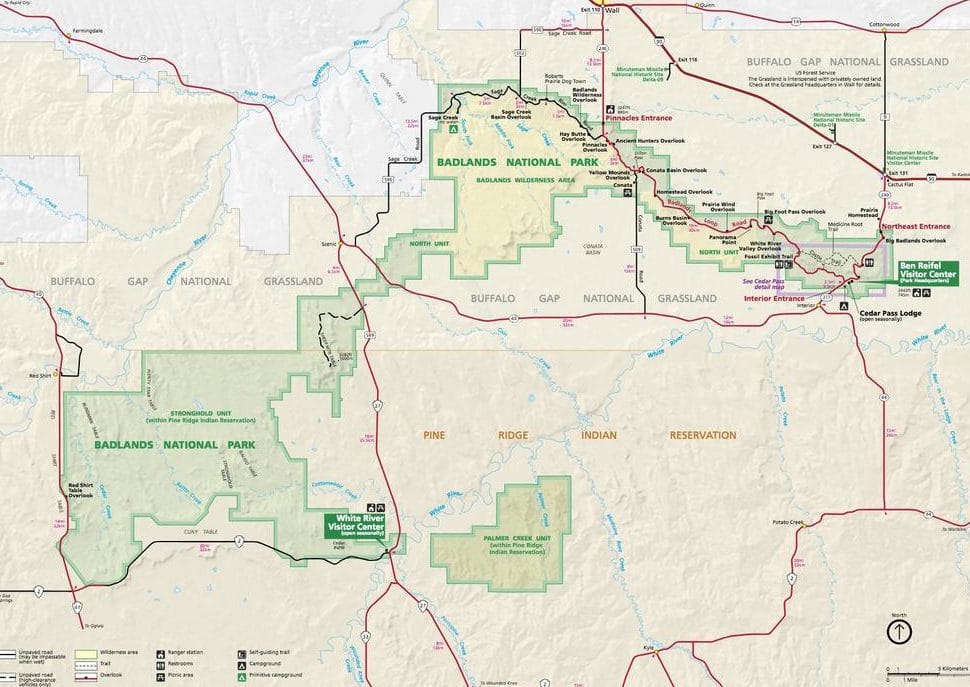
Where is Badlands National Park?
Badlands National Park is located amidst the Northern Great Plains in southwestern South Dakota. The park is about an hour east of Rapid City and nicely paired with a trip to the Black Hills area.
Getting to the Park – Directions & Location
Badlands National Park is located in southwestern South Dakota near the town of Wall (home of the famous Wall Drug roadside attraction)
Closest Airport: RAP – Rapid City Regional Airport (Rapid City)
The fastest way to get to Badlands National Park is almost certainly by flying into Rapid City. From Rapid City (or just Rapid, as the locals call it) you can rent a car and be in the Badlands in under an hour. Rapid City is a terrific gateway city to Badlands National Park, Mount Rushmore, Wind Cave National Park, and the Black Hills National Forest.
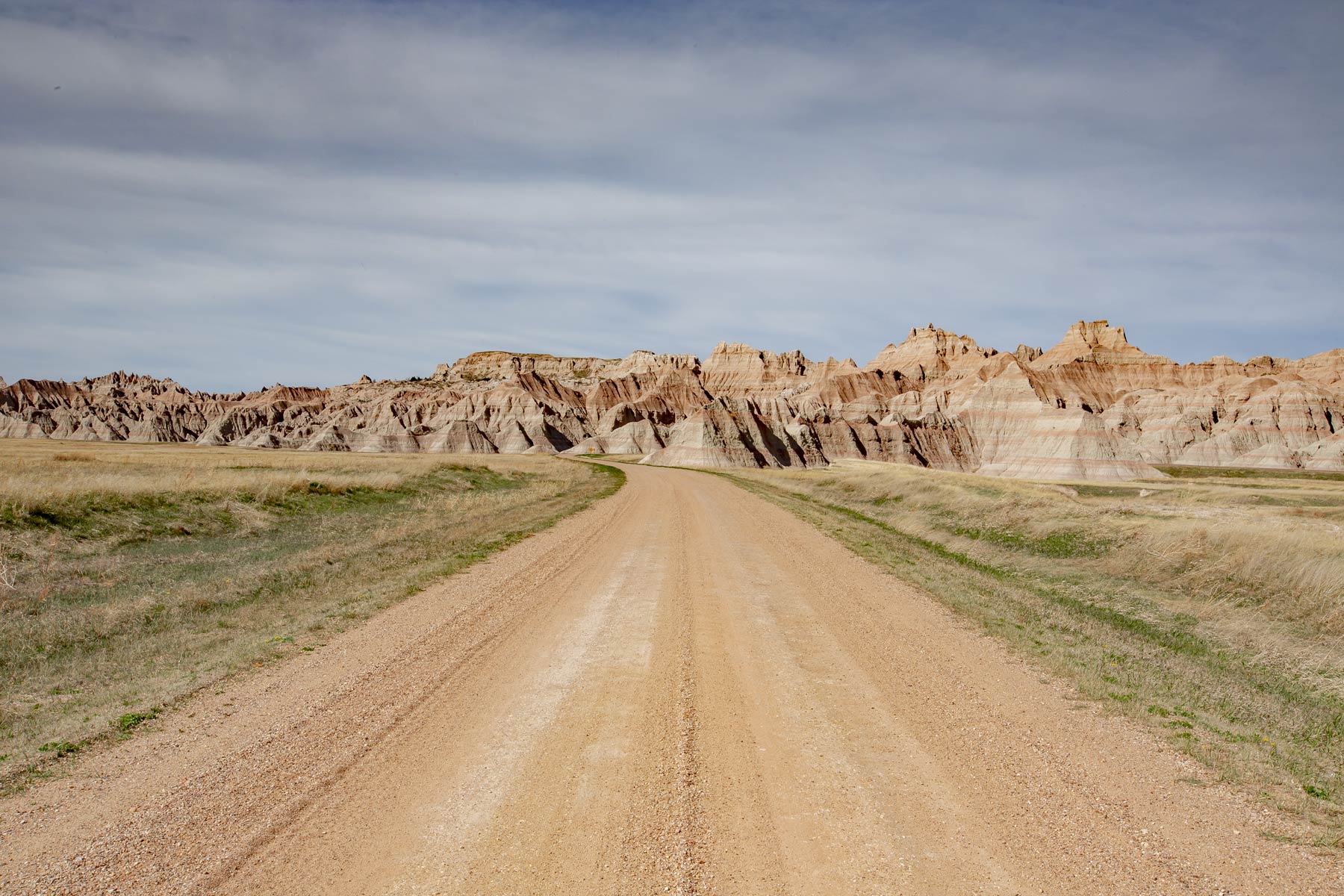
Navigating the Park
Badlands National Park is conveniently located off of Interstate 90 in southwestern South Dakota. You can fly to nearby Rapid City Regional Airport or travel by car via I-90. The nearby town of Wall offers lodging and food options, making for a great base camp for your Badlands adventures – the 5-cent coffee at Wall Drug isn’t bad either!
From I-90, you’ll exit for Badlands National Park and arrive at one of two northerly entrance stations, Pinnacles Entrance Station or Interior Entrance Station. With a park map in hand, you’ll find that navigating the park is very easy as there are only three possible roads you can take.
Popular Roads in Badlands National Park
Badlands Loop Road (Hwy 240) is the main park road and will take you to most of the destinations on your park map.
Sage Creek Rim Road is a dirt road that will take you along the north rim of the Badlands Wilderness Area and allows you to access Sage Creek Campground.
Sheep Mountain Table Road is a 4WD recommended dirt road taking you into the wild heart of the park. The road can be inaccessible at various times throughout the year as a result of storms. It’s recommended to check with the Visitor Center before going.
Things to Keep in Mind
Badlands is an open hike park. This means that you can hike off-trail anywhere inside the park and camp freely in the backcountry as long as you follow backcountry camping rules. You must camp a half mile away from any roads or trails and stay out of sight of the trails & roads.
Badlands is only an hour from Wind Cave National Park, Mount Rushmore, and Black Hills National Forest. So plan a trip to this corner of South Dakota and see them all!
RELATED: 15 HELPFUL Tips for Visiting Mount Rushmore (Things to Do + Photos)
The South Unit of the park is remote and relatively inaccessible. This area is sacred to the Oglala Sioux Tribe, so if you visit, please be respectful and leave any items you find where they are.
Watch the Award-Winning Badlands National Park Video
BADLANDS 8K is the culmination of several weeks spent filming in the rugged Badlands of South Dakota. Situated in the heart of the Northern Great Plains, Badlands National Park spans 244,000 acres of spectacular landscapes, diverse wildlife, and the largest undisturbed mixed grass prairie in the United States.
Journey with More Than Just Parks to discover the land where bison still roam, and towers rise from the prairie in dazzling formations. This is the Badlands.
Best Time to Visit Badlands National Park
Knowing when to visit Badlands National Park will help you make the most of your trip to this great American destination. Certain times of the year will offer the best opportunities to get the most out of your visit.
The best time of year to visit Badlands National Park is May or September in the shoulder seasons when the park is spectacularly empty and the weather is mild.
Summers can be hot and you’ll have to share the park with lots of motorcycles if you plan on visiting in the month leading up to the nearby motorcycle rally in Sturgis. Winter in the park is quite cold, and the area is blanketed in snow.
Badlands National Park Seasons
Spring in Badlands National Park
Spring in the Badlands is windy and still fairly cold, but the grass begins to take on a more vivid green and the entire park is open and accessible. Spring is a great time to go if you want to skip the crowds of summer and don’t mind a little cold.
Plus, the seasonal wildlife has largely returned to the park, including the western meadowlarks, bringing with them the sweet chorus of Spring.rs throughout much of the days.
Summer in Badlands National Park
Summer in the Badlands gets HOT. Temperatures can routinely soar into the upper 90s and even triple digits while the prairie sun beats down on you. If you don’t mind the heat, it’s a great time to visit with magical sunsets and pleasant mornings and evenings.
Nearby Wall is fully open and offers more amenities during the summer months as well.
With the summer also comes crowds so be prepared to share the park’s main attractions with lots of other tourists and plenty of motorcycles.
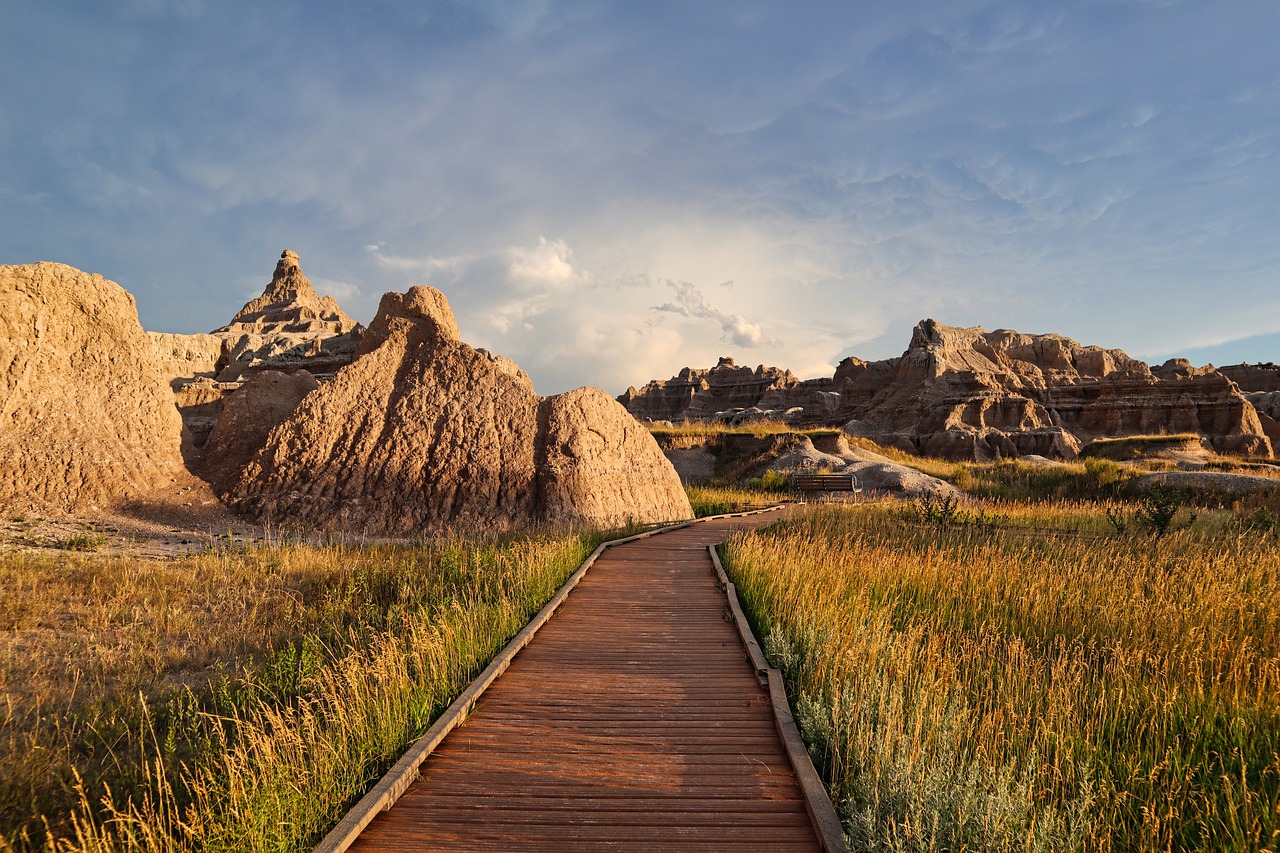
Fall in Badlands National Park
Fall is a great time of year to visit the Badlands if you don’t mind a little sweater weather. Afternoons are pleasant and the park is mostly devoid of the busy summer crowds. September is a great time to visit before it gets too cold.
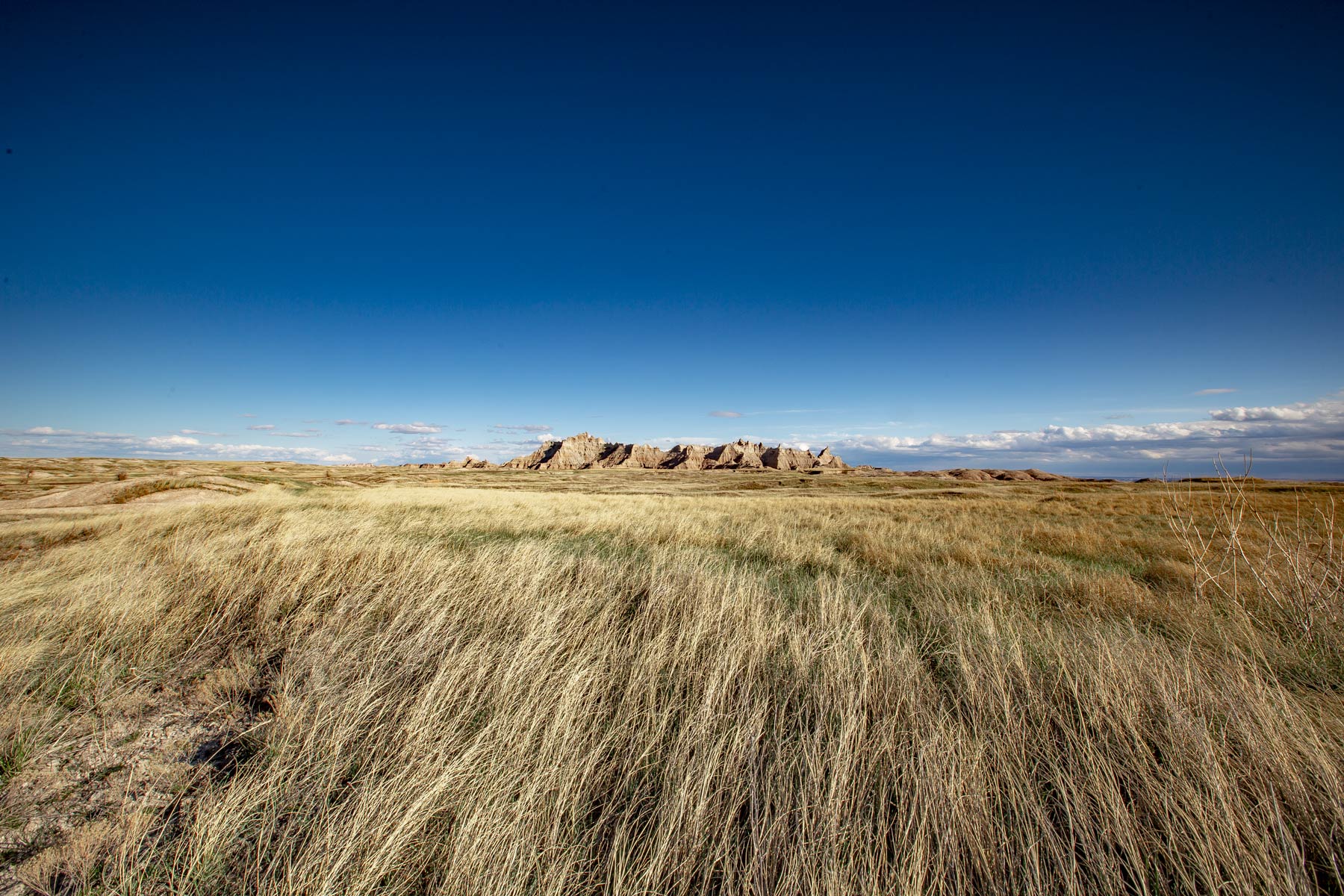
Winter in Badlands National Park
Winter here is typically cold, harsh, and desolate. What life there is on the prairie seeks shelter from the elements wherever they can find it. The prairie dogs keep to their burrows and the birds have long since left for greener pastures down south.
You’re likely to see snow-draped bison roaming the white prairie in search of food and shelter.
If you don’t mind snow and cold weather and want to see the area transformed this can still be a great time to visit. Please note that most nearby services and seasonal roads are closed during winter.
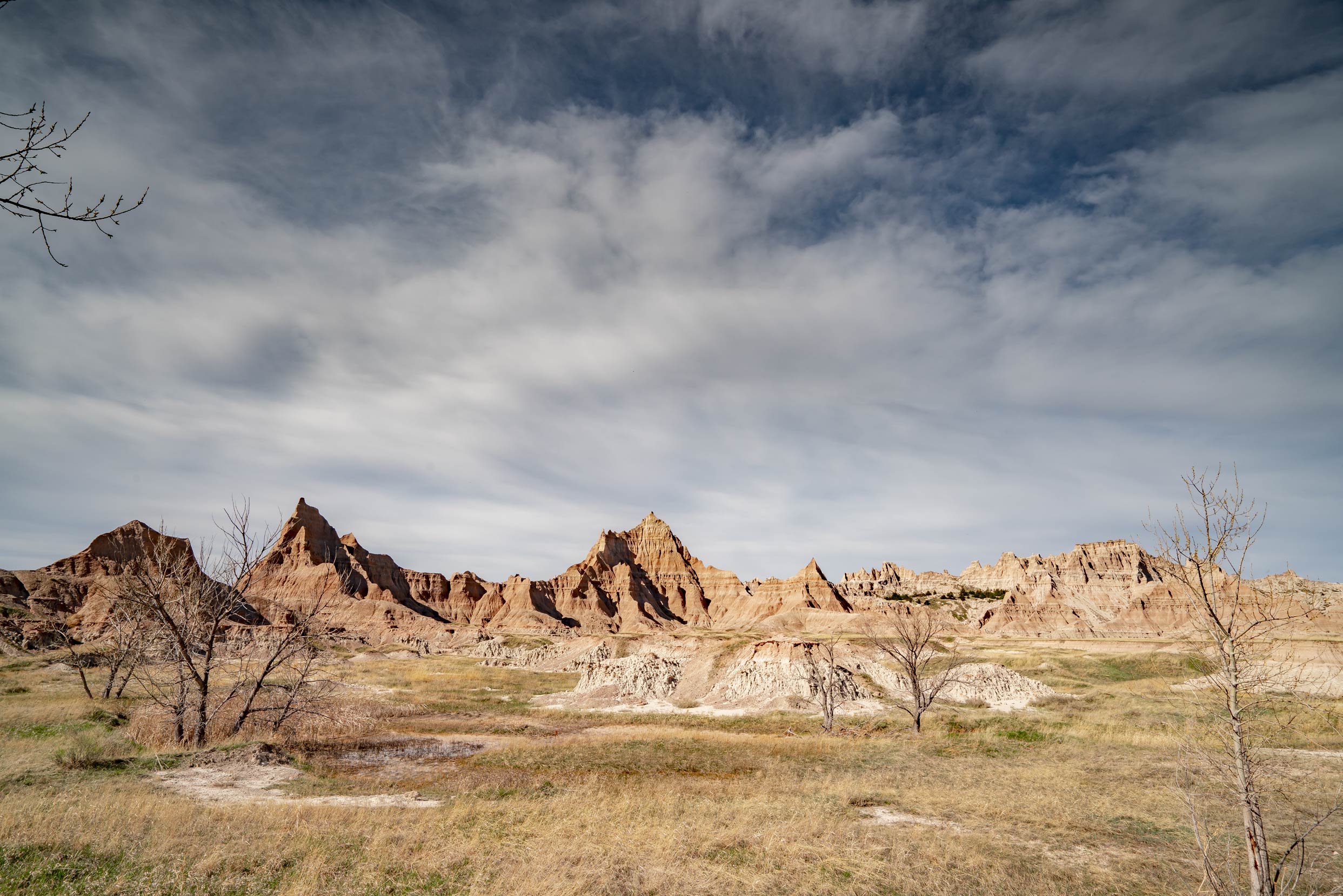
Best Things to Do in Badlands National Park
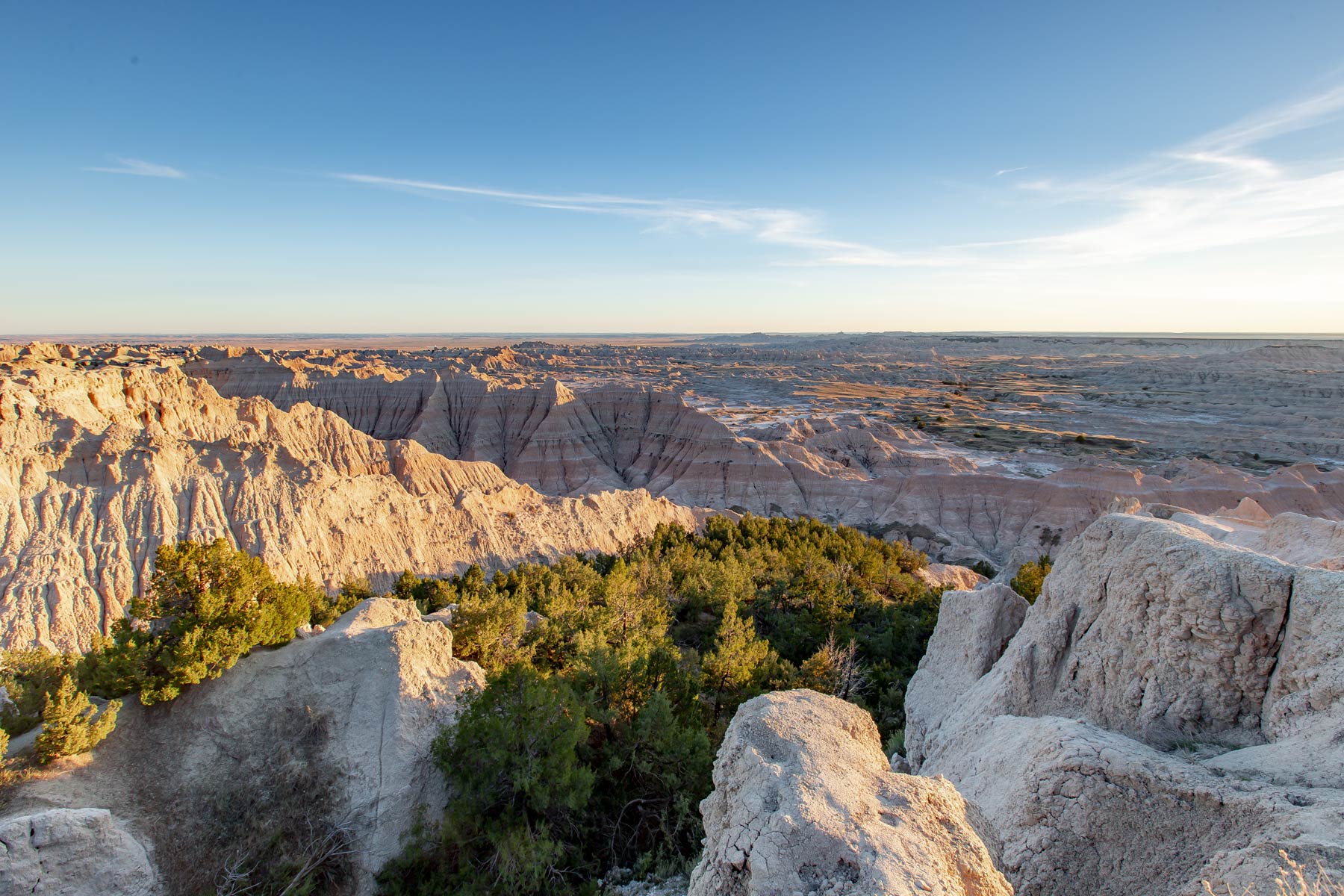
1. Take in the Views
Badlands National Park offers countless overlooks, each with their own unique views of this endlessly fascinating spot on earth. Peer out over an overlook and gaze at the perfectly striped hills continuing into the distance.
Listen for the sound of Bighorn Sheep effortlessly ambling up and down the ridge lines. Spot a lone bison on a distant patch of earth and listen to the wind rustle the tall native grass. It’s about as “national park” as it gets.
2. See the Emblem of the American West
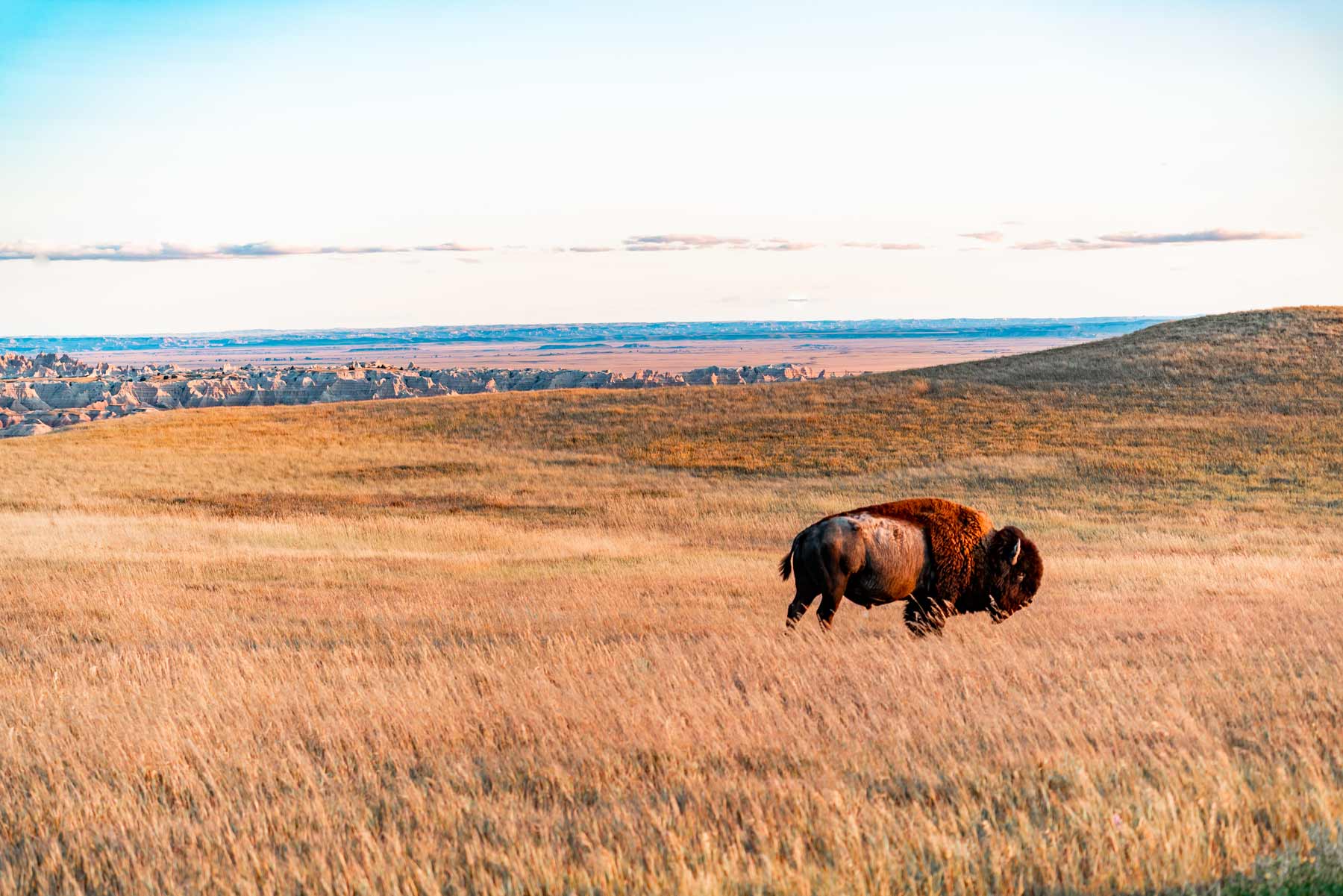
Perhaps more iconic than the Badlands themselves, the park’s many resident bison are truly a sight to behold. These mammoth animals seem right at home amidst the swaying grass and endless vistas of the badlands. Any visit to the park will bring you up close to these beautiful animals for an unforgettable national parks moment.
Note: Please remember to keep a safe and respectable distance from the bison, they are powerful animals and can be very dangerous if approached.
3. Take in a Badlands Sunset
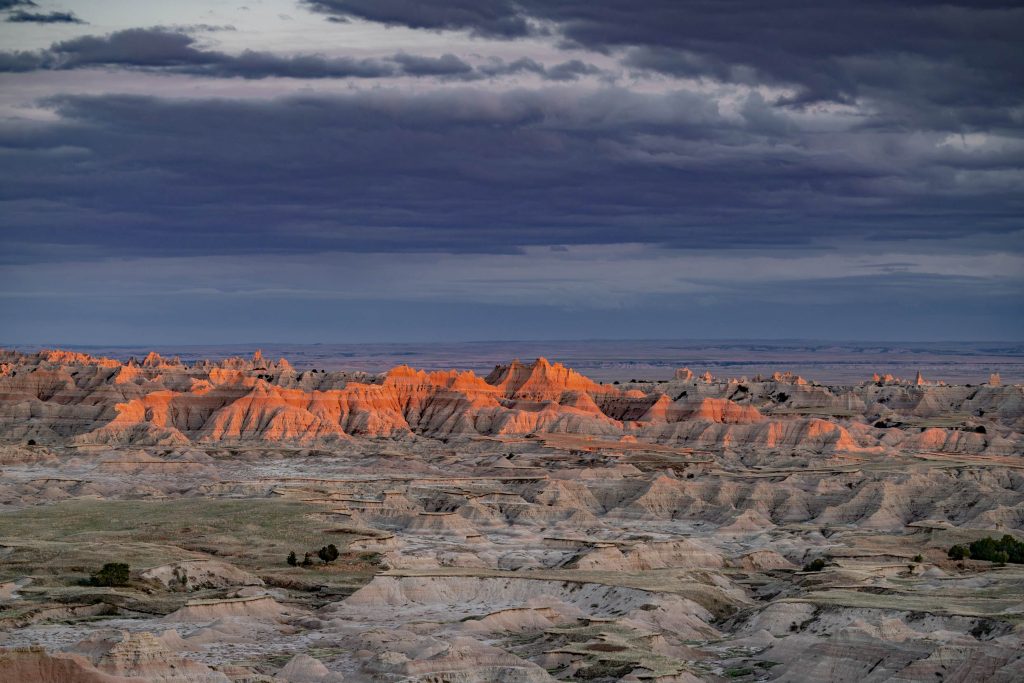
This should probably be #1. The world seems to stand still as the light sweeps across the castle-like peaks of the badlands and continues on into the distance. Looking out over these vast, magnificent vistas as the sunset paints them in brilliant hues is truly a sight to behold.
Badlands National Park boasts several fantastic overlooks where you’ll have the opportunity to see these incredible sunsets first hand.
4. Explore the Badlands
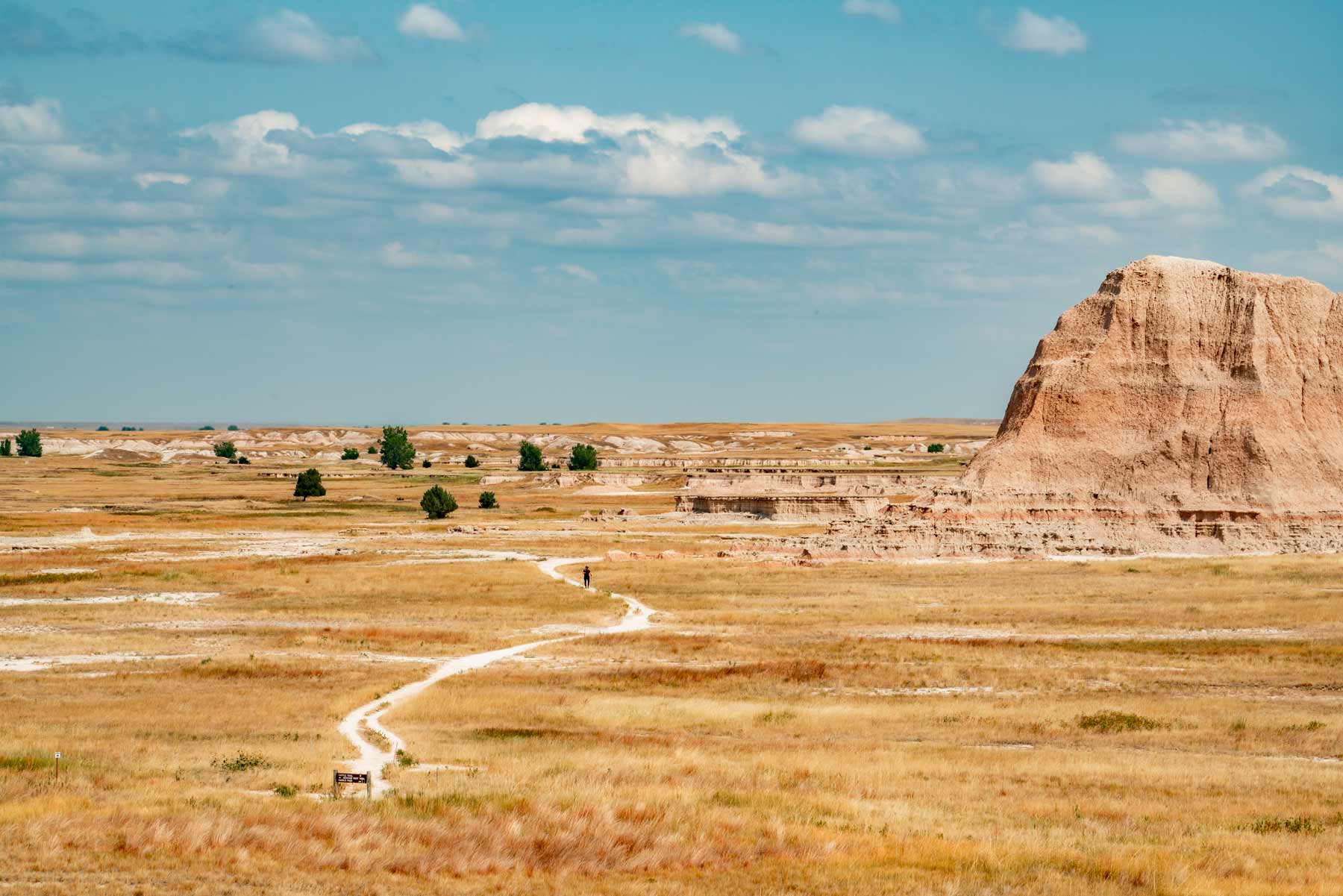
There’s something exhilarating about setting off on a trail here where you can gaze into the distance and see nothing but more badlands. Find the right trail for you by visiting the park Visitors Center or consulting the park website and set out for a magical national park experience.
Don’t forget that Badlands is also an open hike park, meaning you can literally set off and hike anywhere you like. Isn’t that an exciting prospect? (Remember to always have a plan and let others know where you’re headed if you decide to set off).
5. Stargaze in Big Sky Country
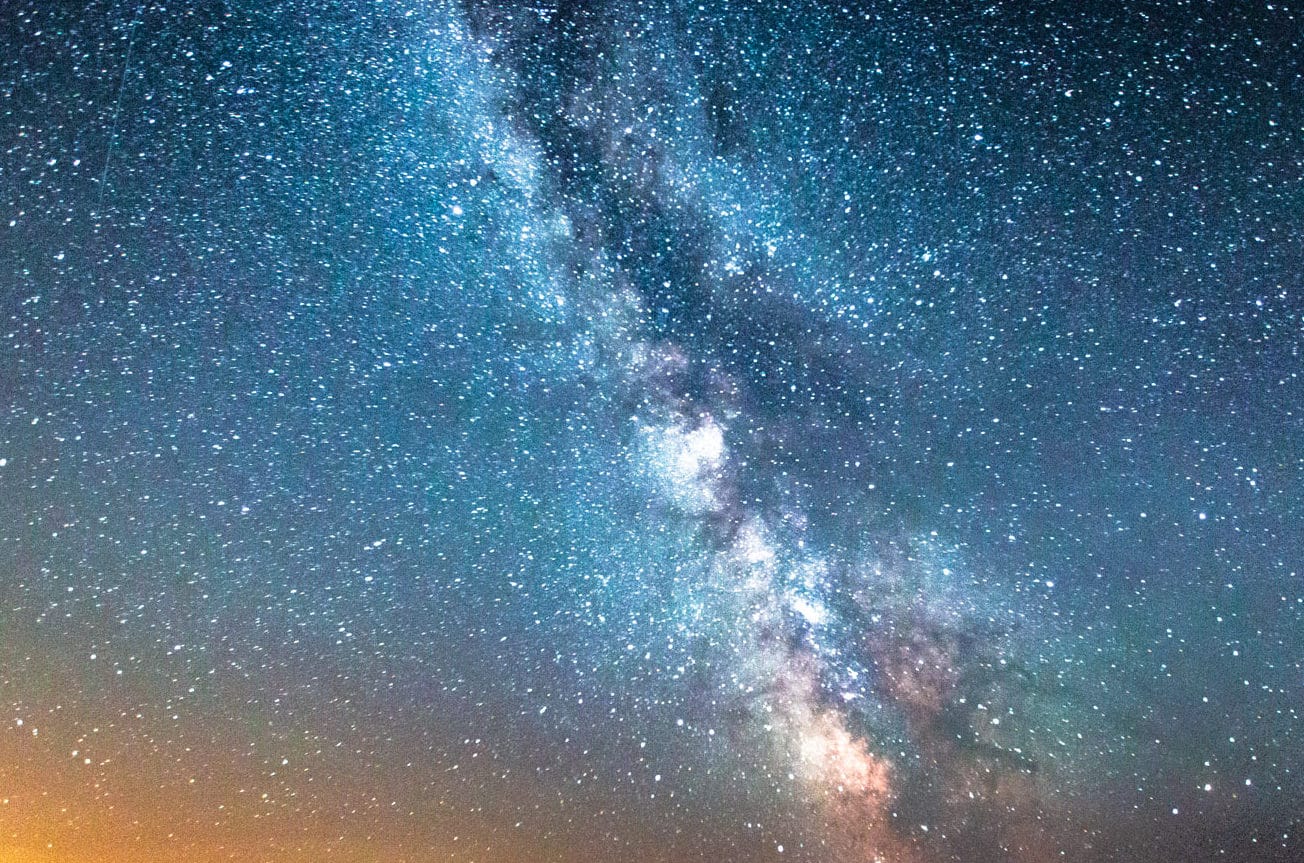
Badlands National Park offers spectacular stargazing opportunities due to its rural setting and near total lack of light pollution. From almost any part of the park you can take in unimpeded views of the vast South Dakota night sky.
Where to Stay – Camping & Lodging
Camping
Badlands National Park has two campgrounds, each offering a different type of camping experience. Read on to find the right one for you.
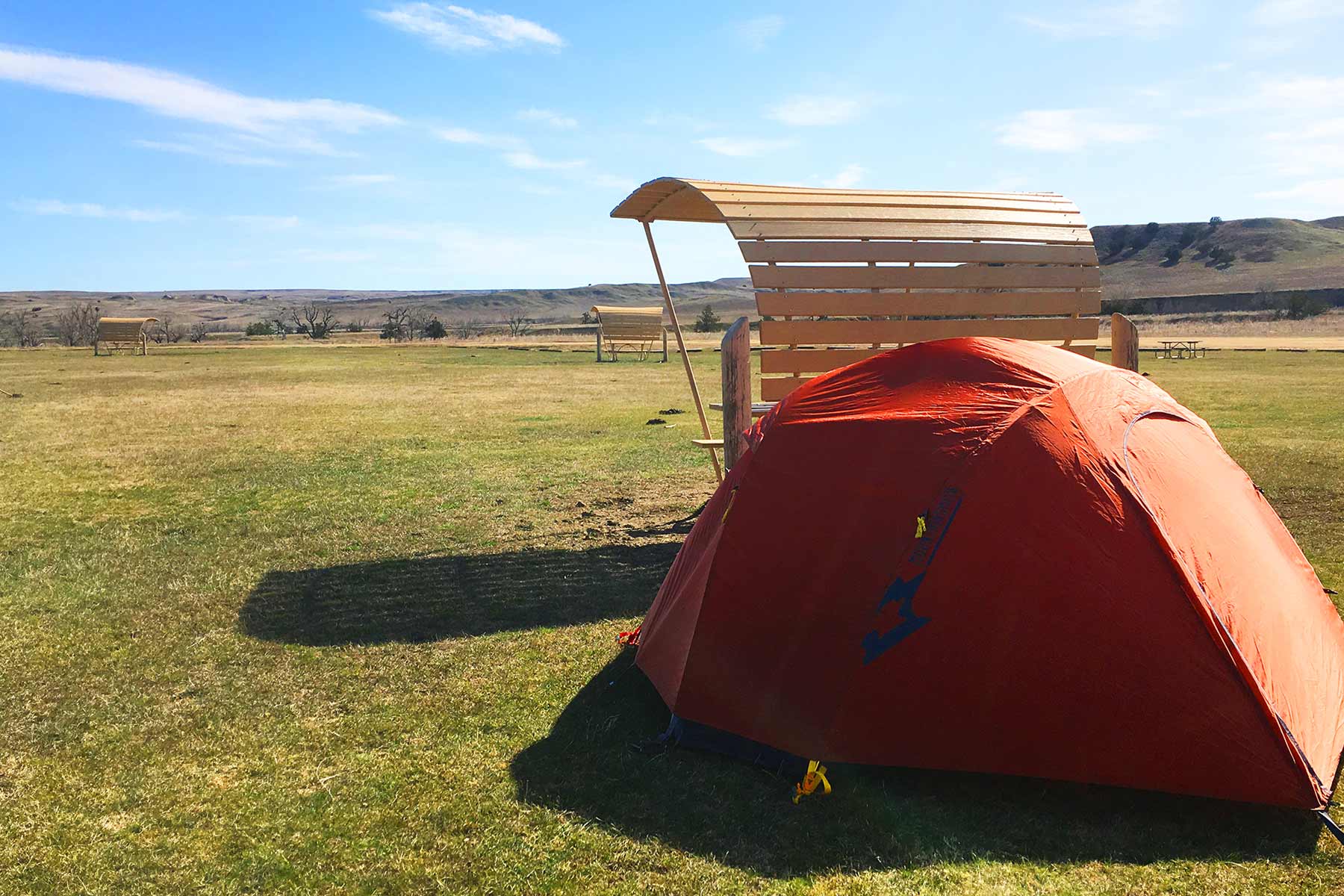
Campgrounds
Cedar Pass Campground, next to the Ben Reifel Visitor Center, offers 96 reservable campsites with 4 group sites available. Fees vary depending on your vehicle and how you will be camping. It is recommended that you visit the Cedar Pass Lodge website to make reservations or check availability. There are no campfires allowed in this campground.
Sage Creek Campground is a free, first-come-first-serve campground located off of a dirt road in a more remote section of the park. There are 22 campsites, and no RVs or trailers are allowed. Campfires are not permitted.
Backcountry Camping is also a great way to explore the park. Badlands National Park is an open hike park, which means that you can hike and camp nearly anywhere inside the park as long as you follow backcountry camping rules.
You must camp a half mile away from any roads or trails and stay out of sight of the trails & roads. Be sure to get a map and register at a backcountry registration station. For more information on backcountry camping in Badlands National Park visit the park website.
Lodging
Badlands National Park is located in a rural area with limited lodging options. However, there are still some great places to stay. We’ve linked the most popular ones below. For tent options, see the camping section above.
Lodging options around the park include:
- Best Western Plains Motel (Wall)
- Super 8 by Wyndham (Wall)
- Econo Lodge (Wall)
- Thunderbird Lodge (International Falls)
- Days Inn (Wall)
- Travelodge (Wall)
- Americas Best Value Inn (Wall)
Where to Eat – Restaurants
The nearby town of Wall, South Dakota, is home to the world-famous tourist attraction Wall Drug, which is a must-see. You will no doubt become familiarized with this famous interstate destination on your way to the park as it is cleverly advertised for hundreds of miles.
Apart from Wall Drug, there are a number of other places to grab a bite to eat close to the park; I’ve linked the most popular ones below:
- Wall Drug (Wall)
- Red Rock Restaurant (Wall)
- Badlands Bar (Wall)
- Cedar Pass Lodge & Cafe (The only restaurant within the park)
- Subway (Wall)
- Horseshoe Bar & Grill (Interior)
My Favorite Spot in Badlands National Park
Hay Butte Overlook offers, in my mind, perhaps the best view in the park. Here, you can look out at what makes this place so special: a seemingly endless maze of striped pinnacles and towers rising above the surrounding prairie in stunning fashion.
You’ll see bison roaming in the distance, bighorn sheep gliding up and down the hills, and hear the song of the western meadowlark amidst the tall native grasses of the prairie. Sunset here is where the park really stands out.
The world seems to stand still as you watch the light sweep across the castle-like peaks of the badlands and continue on into the distance. There are few better views than one enjoyed alone overlooking this vast and beautiful expanse at sunset.

Photo Gallery – Badlands National Park
Photos from the production of our Badlands Film.
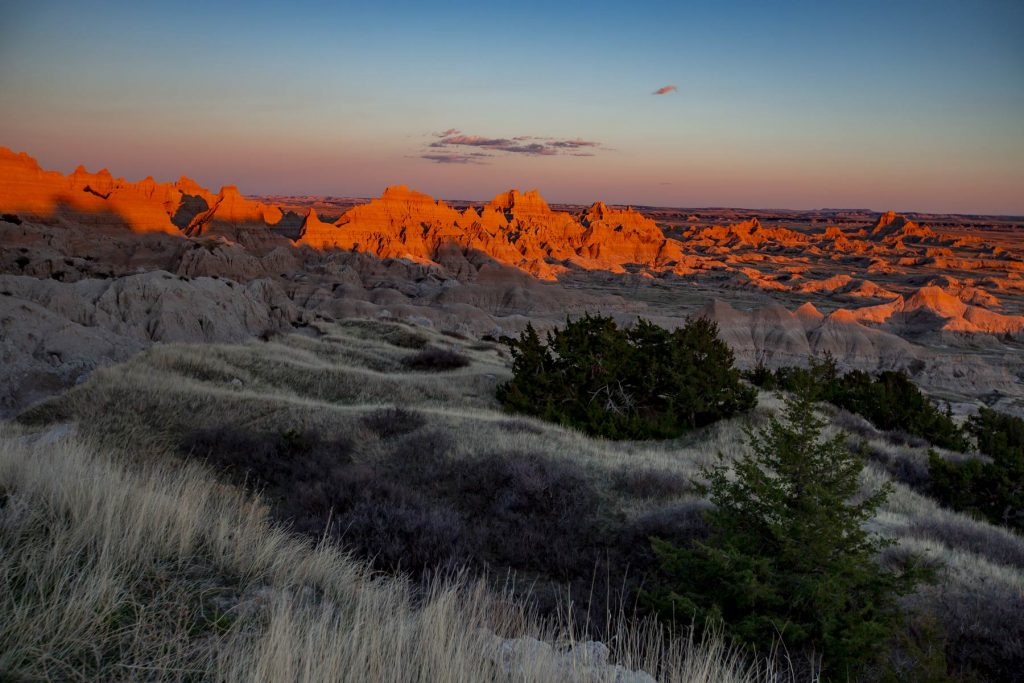

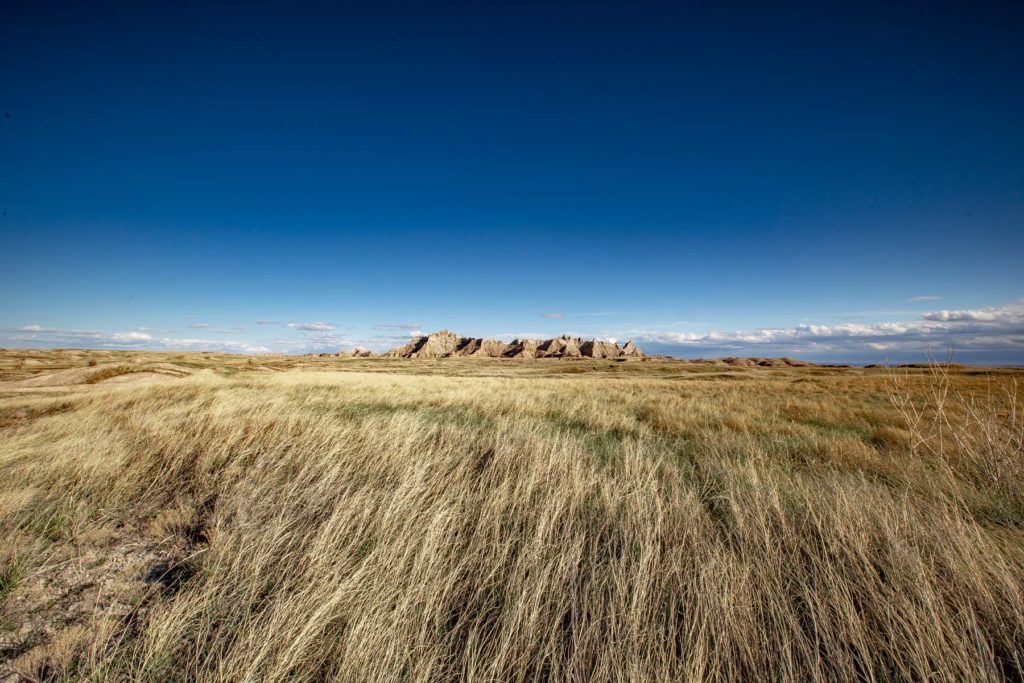

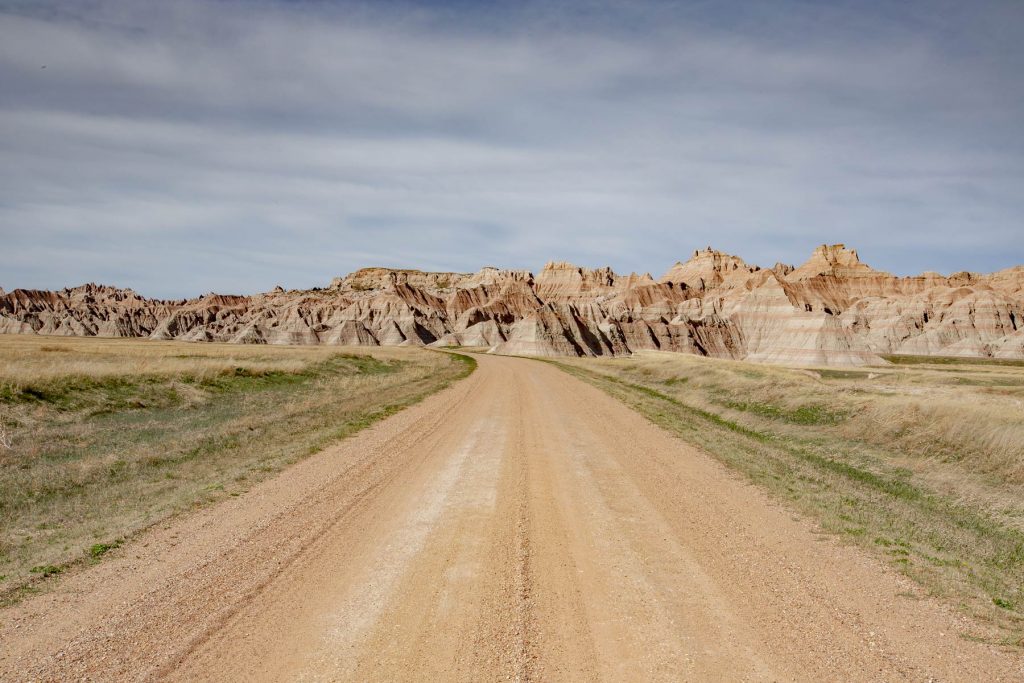
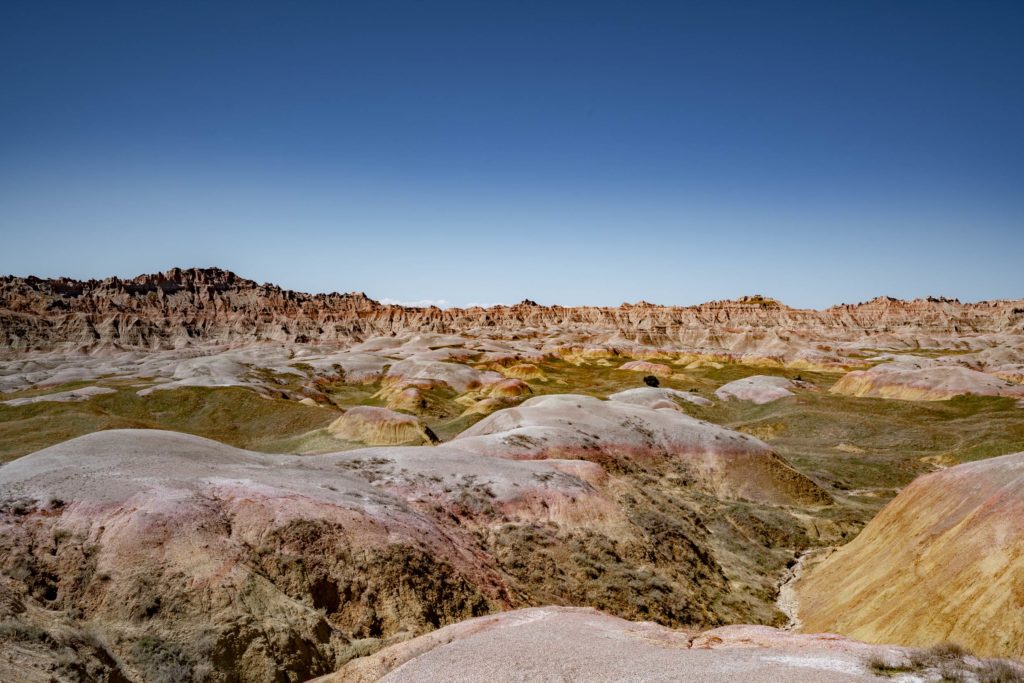
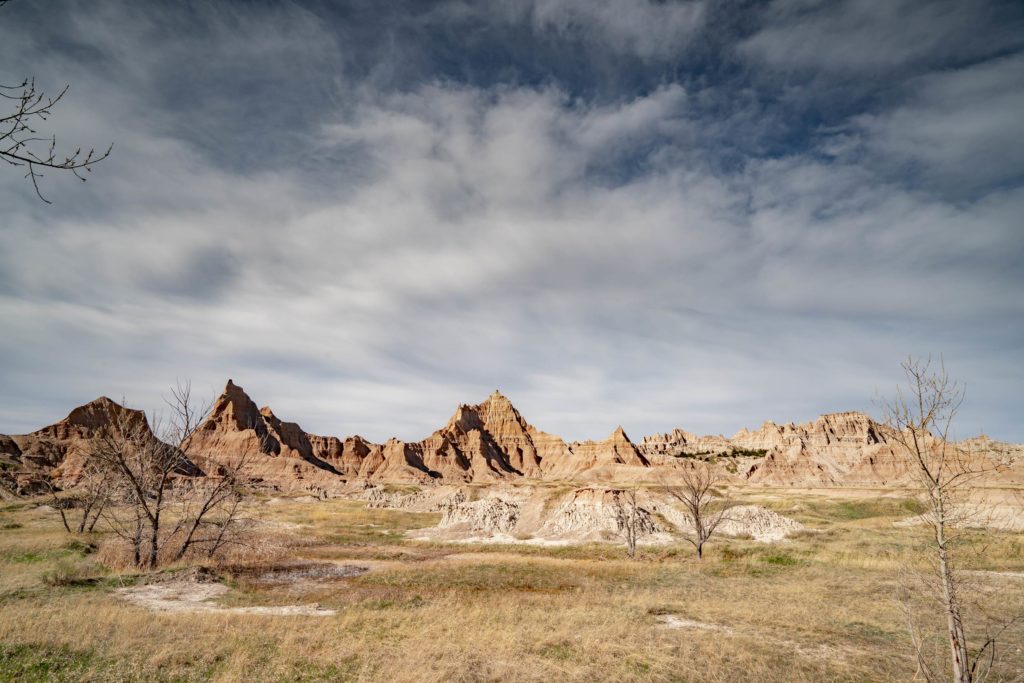
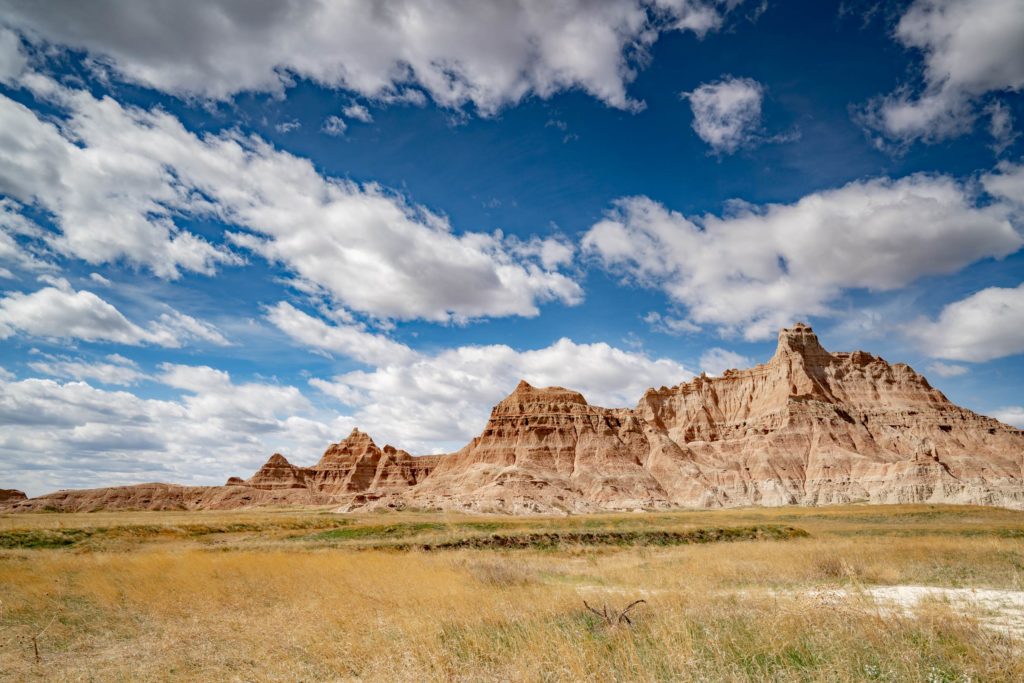
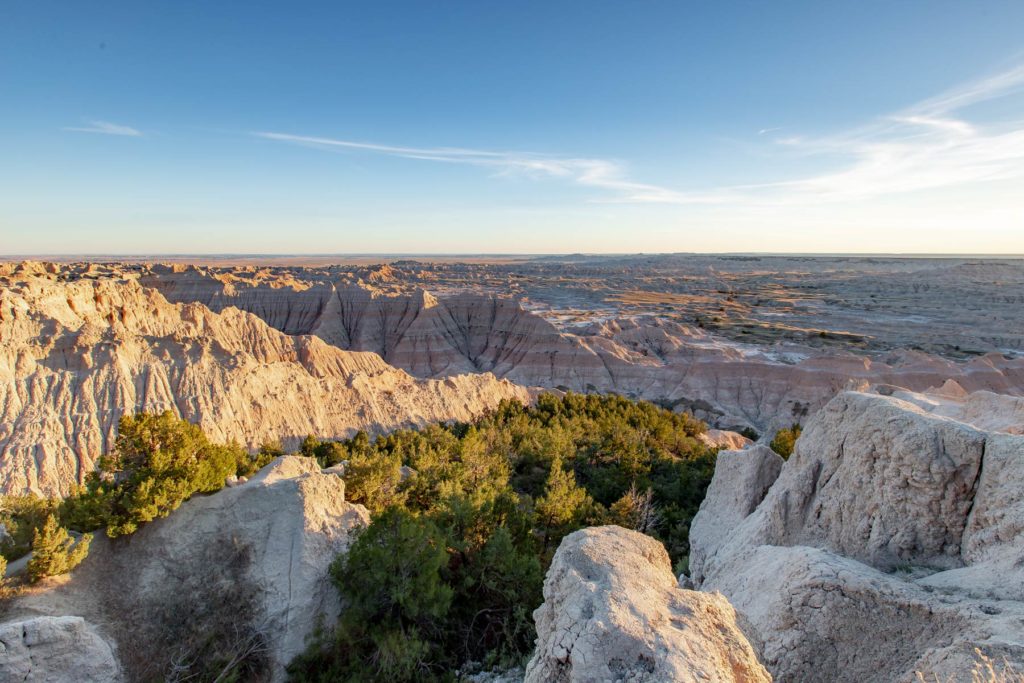

Nearby Attractions
- Black Hills National Forest
- Mount Rushmore National Memorial
- Wind Cave National Park
- Devils Tower National Monument
- Jewel Cave National Monument
- Minute Man Missile National Historic Site
See Our Full National Park Rankings
We actually ranked ALL 63 National Parks from best to worst using the same point system featured in this article here. Curious to see how Badlands stack up against the rest of the parks nationwide? Click here!
Summary | Leave Us a Comment!
That’s a wrap! Hopefully, you feel like you’ve gleaned everything you need to know for your next trip to Badlands National Park. Feel free to leave a comment below and let me know if you have any questions or thoughts!
Hope to see you on the trails sometime soon!
More Helpful Articles
Hiking the Castle Trail: Castle Trail: Epic Hikes in Badlands National Park (Photos + Guide)
Hiking the Notch Trail: Hiking the Notch Trail in Badlands National Park (Photos + Guide)
Badlands NP Guide: Helpful Guide to Badlands National Park
Things to Do in Badlands: 20 Incredible Things to Do in Badlands National Park
Visiting Mount Rushmore: 15 Helpful Tips for Visiting Mount Rushmore
Things to Do Near Rushmore: 25 Epic Things to Do Near Mount Rushmore
Black Hills National Forest: Comprehensive Guide to the Black Hills National Forest

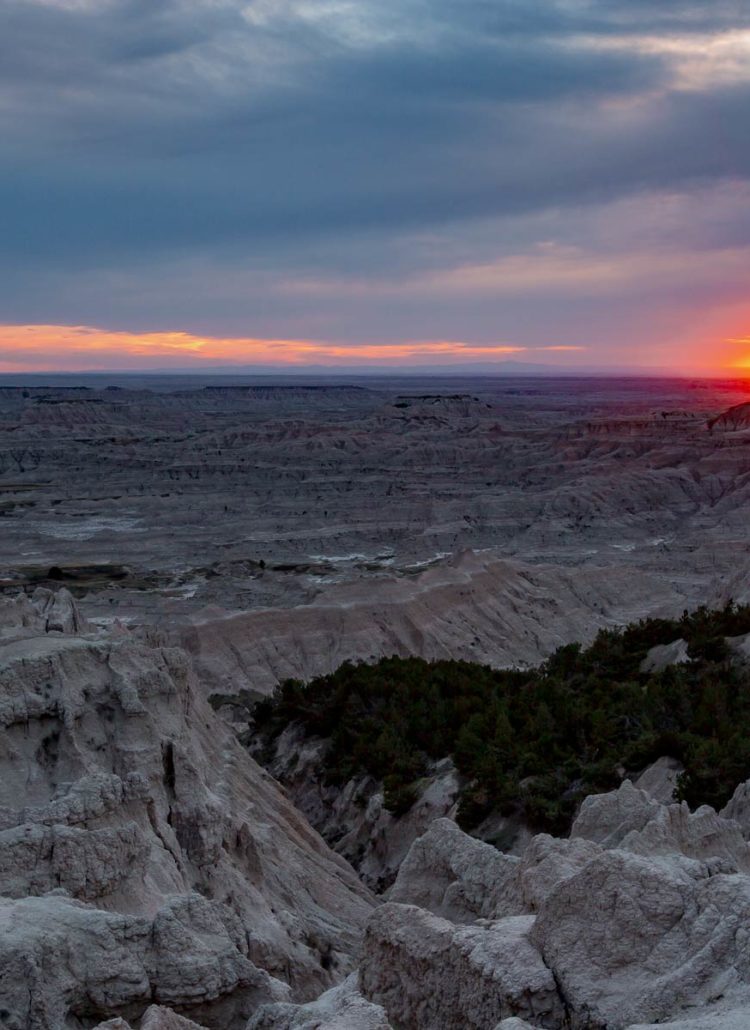
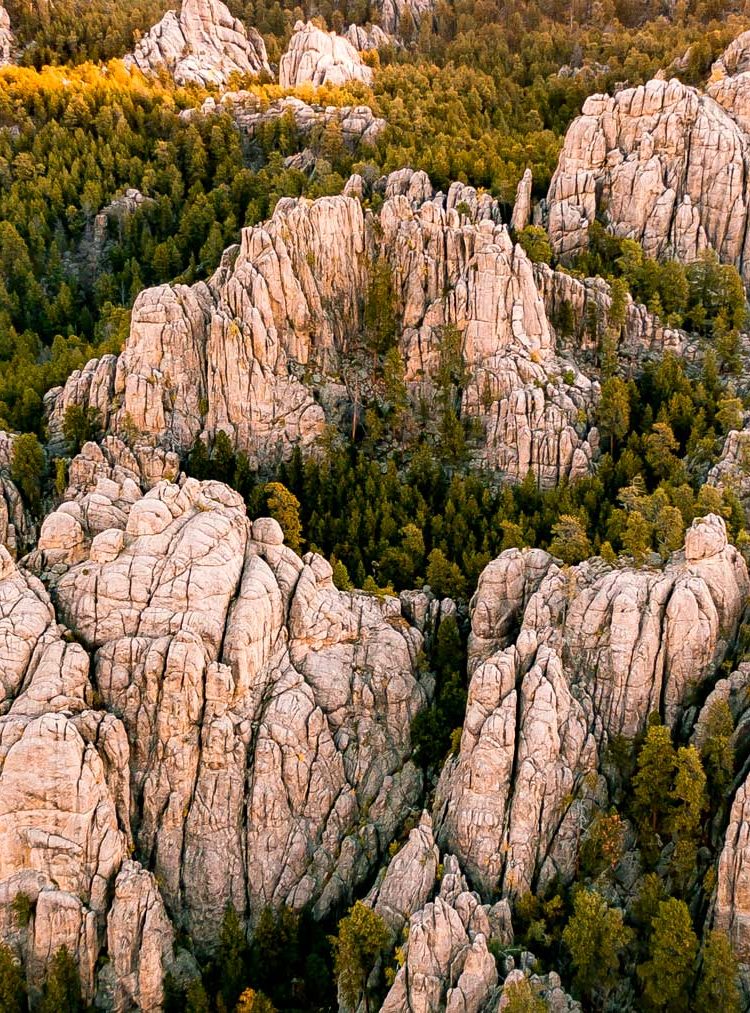
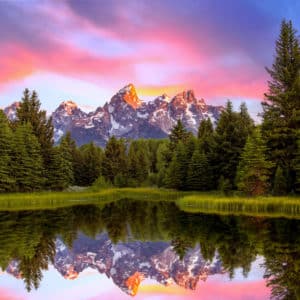

Thank you for this beautifully written and easy to understand article. The stories of the Natives just has me in tears, it’s truly despicable. You’re well researched, and I appreciate your sharing with us all.